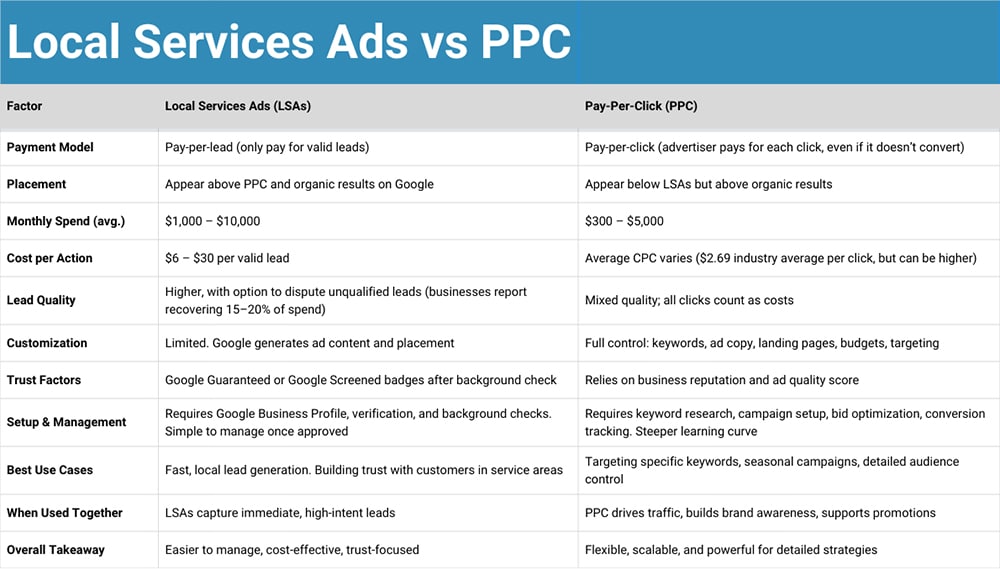
When you’re deciding how to spend your digital marketing budget, one common question comes up: should you focus on Pay-Per-Click (PPC) advertising or Local Services Ads (LSAs)?
Both options can generate new leads, but they work in different ways.
PPC gives you control over targeting and messaging, while LSAs provide high visibility and trust signals at the top of Google search results.
Understanding the differences will help you decide which strategy works best for your goals, or if combining them is the smartest approach.
1. What Are LSAs and PPC?
Local Services Ads (LSAs)
Local Services Ads are a pay-per-lead model. Instead of paying for every click, you only pay when a potential customer contacts you directly through the ad. LSAs appear above traditional PPC ads and organic results, giving them prime real estate on Google search pages.
Businesses can qualify for Google Guaranteed Ads or Google Screened Ads after passing a background check and verification process. These badges add a layer of credibility that reassures searchers they’re dealing with a trusted business.
Pay-Per-Click (PPC) Advertising
PPC advertising, most often run through Google Ads, is a pay-per-click model where the advertiser pays whenever someone clicks on the ad.
PPC offers flexibility across multiple ad formats such as search ads, display ads, shopping ads, video ads, and more. Unlike LSAs, PPC campaigns allow advertisers to choose keywords, create landing pages, and design custom ad copy.
Key takeaway:
- Local Services Ads (LSAs) emphasize trust and visibility with minimal setup.
- Pay-Per-Click (PPC) provides a wider range of options and full control over targeting and messaging.
2. Cost and Lead Quality: Which Delivers More Value?
- PPC Ads: On average, small to mid-sized businesses can spend between $300 to $5,000 per month, including management fees and ad spend. Each click has a cost, even if it doesn’t lead to a customer.
- LSAs: On average, small to mid-sized businesses can spend between $1,000 to $10,000 per month. Businesses only pay for valid leads, typically ranging from $6 to $30 per lead. Some companies report recovering 15% – 20% of their LSA budget by disputing unqualified leads.
Lead Quality
With PPC, any click counts as a cost, whether or not the visitor converts. LSAs, on the other hand, allow disputes for leads that don’t meet your criteria. For example, calls from outside your service area or irrelevant requests.
Key takeaway:
- LSAs reduce wasted spend by charging only for valid leads.
- PPC can generate large volumes of traffic but requires close monitoring to protect your budget.
3. Control, Customization, and Trust
PPC Control
PPC campaigns are highly customizable. You can:
- Select the exact keywords you want to target.
- Build landing pages tailored to customer intent.
- Adjust budgets, bids, and ad extensions.
- Exclude irrelevant searches with negative keywords.
This level of control makes PPC powerful for businesses with a clear marketing strategy and resources for campaign management.
LSA Trust Signals
Local Services Ads don’t offer the same customization, but they come with trust factors built in.
The Google Guaranteed and Google Screened badges show potential customers that your business has passed a background check and meets Google’s standards. This reassurance can be a deciding factor in high-intent searches.
Key takeaway:
- PPC gives advertisers precision and flexibility.
- LSAs build trust quickly with the Google Guarantee or Screened badge.
4. Setup and Management: What’s Easier?
Setting Up PPC
Launching PPC campaigns involves keyword research, creating ad groups, writing copy, setting up conversion tracking, and optimizing bids.
It’s highly effective but can be a steep learning curve for those without experience. Many businesses hire agencies to manage PPC campaigns to maximize performance and ROI.
Setting Up LSAs
Local Services Ads require a Google Business Profile and a verification process that includes licensing and insurance checks, plus a background check. Once approved, setup is straightforward.
You choose services, set a budget, and let Google handle much of the ad placement.
Key takeaway:
- PPC campaigns require active management and expertise.
- LSAs are simpler to run, making them appealing for busy local businesses.
5. When to Use LSAs, PPC, or Both
LSAs Work Best When:
- You want immediate local visibility at the top of Google search results.
- You prefer a pay-per-lead model where you only pay for actual customer contacts.
- You want to leverage the Google Guarantee badge to build trust.
PPC Works Best When:
- You want to target specific keywords or long-tail searches.
- You need to run promotions, seasonal offers, or awareness campaigns.
- You want control over ad rankings, landing pages, and budgets.
Using Both Together
The strongest strategy often involves running LSAs and PPC side by side.
- LSAs capture immediate, local, high-intent leads.
- PPC expands reach, drives traffic to your website, and builds brand awareness.
- Appearing in both ad sections keeps your business in front of customers multiple times during their search journey.
A report from Google has shown that businesses running both LSAs and PPC campaigns see higher click-through rates and better conversion outcomes compared to using one format alone.
Key takeaway:
- LSAs and PPC aren’t competitors. They complement each other.
- Running both creates a stronger digital marketing funnel.
Comparison Table
Conclusion
For local businesses in Austin and beyond, Local Services Ads and PPC advertising both play an important role in digital marketing.
LSAs are cost-effective, trust-building, and easier to manage, while PPC campaigns deliver flexibility, customization, and broader reach.
At Website Design Austin Texas, we recommend evaluating your lead generation goals, budget, and resources.
In many cases, combining LSAs with a strong PPC strategy provides the best return on investment and maximizes visibility where it matters most: on Google’s search results page.

